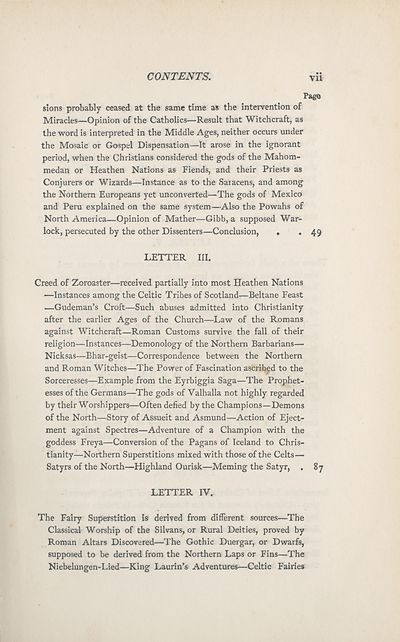Download files
Complete book:
Individual page:
Thumbnail gallery: Grid view | List view

CONTENTS.
vii
Page
sions probably ceased at the same time as the intervention of
Miracles—Opinion of the Catholics—Result that Witchcraft, as
the word is interpreted in the Middle Ages, neither occurs under
the Mosaic or Gospel Dispensation—It arose in the ignorant
period, when the Christians considered the gods of the Mahom-
medan or Heathen Nations as Fiends, and their Priests as
Conjurers or Wizards—Instance as to the Saiacens, and among
the Northern Europeans yet unconverted—The gods of Mexico
and Peru explained on the same system—Also the Powahs of
North America—Opinion of Mather—Gibb, a supposed War-
lock, persecuted by the other Dissenters—Conclusion, . . 49
LETTER III.
Creed of Zoroaster—received partially into most Heathen Nations
—Instances among the Celtic Tribes of Scotland—Beltane Feast
—Gudeman’s Croft—Such abuses admitted into Christianity
after the earlier Ages of the Church—Law of the Romans
against Witchcraft—Roman Customs survive the fall of their
religion—^Instances—Demonology of the Northern Barbarians—
Nicksas—Bhar-geist—Correspondence between the Northern
and Roman Witches—The Power of Fascination ascribed to the
Sorceresses—Example from the Eyrbiggia Saga—The Prophet¬
esses of the Germans—The gods of Valhalla not highly regarded
by their Worshippers—Often defied by the Champions—Demons
of the North—Story of Assueit and Asmund—Action of Eject¬
ment against Spectres—Adventure of a Champion with the
goddess Freya—Conversion of the Pagans of Iceland to Chris¬
tianity-Northern Superstitions mixed with those of the Celts—
Satyrs of the North—Highland Ourisk—Meming the Satyr, . 87
LETTER IV.
The Fairy Superstition is derived from different sources—The
Classical Worship of the Silvans, or Rural Deities, proved by
Roman Altars Discovered—The Gothic Duergar, or Dwarfs,
supposed to be derived from the Northern Laps or Fins—The
Niebelungen-Lied—King Laurin’s Adventures—Celtic Fairies
vii
Page
sions probably ceased at the same time as the intervention of
Miracles—Opinion of the Catholics—Result that Witchcraft, as
the word is interpreted in the Middle Ages, neither occurs under
the Mosaic or Gospel Dispensation—It arose in the ignorant
period, when the Christians considered the gods of the Mahom-
medan or Heathen Nations as Fiends, and their Priests as
Conjurers or Wizards—Instance as to the Saiacens, and among
the Northern Europeans yet unconverted—The gods of Mexico
and Peru explained on the same system—Also the Powahs of
North America—Opinion of Mather—Gibb, a supposed War-
lock, persecuted by the other Dissenters—Conclusion, . . 49
LETTER III.
Creed of Zoroaster—received partially into most Heathen Nations
—Instances among the Celtic Tribes of Scotland—Beltane Feast
—Gudeman’s Croft—Such abuses admitted into Christianity
after the earlier Ages of the Church—Law of the Romans
against Witchcraft—Roman Customs survive the fall of their
religion—^Instances—Demonology of the Northern Barbarians—
Nicksas—Bhar-geist—Correspondence between the Northern
and Roman Witches—The Power of Fascination ascribed to the
Sorceresses—Example from the Eyrbiggia Saga—The Prophet¬
esses of the Germans—The gods of Valhalla not highly regarded
by their Worshippers—Often defied by the Champions—Demons
of the North—Story of Assueit and Asmund—Action of Eject¬
ment against Spectres—Adventure of a Champion with the
goddess Freya—Conversion of the Pagans of Iceland to Chris¬
tianity-Northern Superstitions mixed with those of the Celts—
Satyrs of the North—Highland Ourisk—Meming the Satyr, . 87
LETTER IV.
The Fairy Superstition is derived from different sources—The
Classical Worship of the Silvans, or Rural Deities, proved by
Roman Altars Discovered—The Gothic Duergar, or Dwarfs,
supposed to be derived from the Northern Laps or Fins—The
Niebelungen-Lied—King Laurin’s Adventures—Celtic Fairies
Set display mode to:
![]() Universal Viewer |
Universal Viewer | ![]() Mirador |
Large image | Transcription
Mirador |
Large image | Transcription
| Antiquarian books of Scotland > Curiosities & wonders > Demonology and witchcraft > (11) |
|---|
| Permanent URL | https://digital.nls.uk/130252916 |
|---|
| Description | Thousands of printed books from the Antiquarian Books of Scotland collection which dates from 1641 to the 1980s. The collection consists of 14,800 books which were published in Scotland or have a Scottish connection, e.g. through the author, printer or owner. Subjects covered include sport, education, diseases, adventure, occupations, Jacobites, politics and religion. Among the 29 languages represented are English, Gaelic, Italian, French, Russian and Swedish. |
|---|

